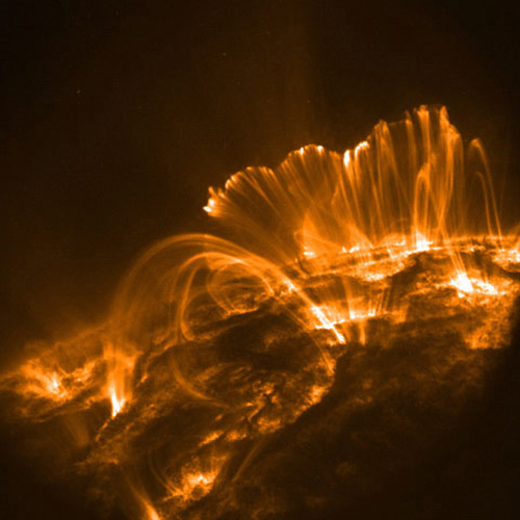Maneuvering Chandra in the Solar Storm
By now you may have seen the headlines:
"Strongest Solar Storm Since 2005 Striking Earth."
"Raging Solar Storm Triggers Northern Lights"
"Solar Storm Is Taste of Things to Come."
Hopefully, for some of you it was a nice view of the northern lights. For us, it was a busy start to the week. This started last Thursday (Jan. 19, 2012) with an M2 solar flare. Flares below M5 usually don't worry us too much, but this one was unusually long - about 6 hours - which indicated a lot of material was involved and coronal mass ejection (CME) was heading our way with a scheduled arrival of Saturday or Sunday. Sure enough on Saturday (Jan. 21), the ACE satellite, the GOES satellites and our on-board monitors started to notice a minor jump in the background particles. The rate got even higher by Sunday. By Sunday night, we had received about half our orbital budget.
When this happened our alerts system went off and we had a phone meeting. This was around half time of the NFC Champion ship game, not that I knew, since I was with my daughters at a Girl Scout camp reunion. So while they were cooking s'mores in the snow, I was on my cell phone. We know that periodically long slow radiation storms will happen and we "budget" for 10 a year. This is the first storm like this in several years. So when we "met", we reviewed how much time was left in the orbit (5 hours) and what additional fraction of out budget we would receive in the next 5 hours assuming either constant or worst-case. Since it was only 5 hours until the end of the orbit, we figured the 50% of the budget might get to 55% so we decided to ride it out, go behind the Earth and start fresh on the next orbit. Little did we know, we'd never get there.

Northern lights dance over the Lyngan Alps in a picture taken Tuesday night near Tromsø, Norway.Photograph by Ole C. Salomonsen, arcticlightphoto.no.
At 11:12 p.m. (all times EST), my pager goes off. An M9 flare...uh-oh, these can cause problems. Well ok, we'll deal with it in the morning, the CMEs usually takes a day or two to get to the Earth. At 1:40 a.m., my pager goes off, high-energy proton rates on the GOES satellite are at one-third the level that Chandra is programmed to react. At 2:10 a.m., the high-energy proton rates exceed the level at which our Chandra should react, and again pagers go off for the third time since bed time.
It took three hours for the high-energy protons to get to the Earth so they were traveling between 30 and 50 million miles per hour -- and didn't even get a speeding ticket. By comparison the relatively low-energy material CME travels at about 1.5 million miles per hour. We decided that in any event the spacecraft had already moved the science instrument to a safe location since it was programmed to do that around 1:00 am in preparation for going near the Earth. We would find out the details at our next contact at 11:30 a.m. Monday.
And, yes, the spacecraft had automatically stowed the instruments almost immediately after the flare. Now we wait. Since the flare, background rates have been too high to restart the science instruments. For us, it is our first test of our new flight software. We no longer tie the motion of the spacecraft to the location of the science instruments. So even though the science instruments are stowed, the spacecraft will still go a point from object to object. Kind of funny when you think about it, the spacecraft is literally going through the motions. But that means Chandra is safe since we carefully choreograph the maneuvers in each orbit to prevent momentum from building up and to keep the temperatures of the spacecraft at the appropriate levels. At 5:00 pm Monday the team met and the rates were still high. The bulk of the CME arrived Tuesday around 10:00 a.m., with low energy protons exceeding their limits by a factor of 4. We hoped to restart Tuesday night with a backup plan of Thursday morning just after midnight. We will have a phone call to discuss this Tuesday night at 10 p.m. As I write this at 9:00 pm, both the low and high energy protons are still above their limits, we typically wait until the values are at one-third of the trip levels so we will have to wait and see.

A close-up view in ultraviolet light of the Sun's edge shows vast looping structures made of blisteringly hot, electrically charged gas (plasma) in the Sun's corona. Here the plasma is caught falling back to the Sun following an explosive solar flare.Credit: NASA/TRACE
Postscript -
10:00 pm Tuesday, Jan. 24th: At least two of our monitors were running at about three times their "trip" levels but falling. I estimated that they would be at one-third their trip levels within about 18 hours. By coincidence (really), 18 hours also happened to be the time until the orbit ended. So we decided to let things end without restarting science and tag back in 18 hours.
4:00 p.m. Wednesday, Jan 25th: By then the space weather was about what it had been Sunday night at halftime of the NFC championship except the space weather was clearing (and the for the part about the 49ers still having a chance to win the Super Bowl). We set up to restart science at 3:30 a.m. Thursday morning.
10:30 a.m. Thursday, Jan. 26th: As of this morning, we have now re-commenced science observations.
NASA's page where they are updating on the solar storms:
http://www.nasa.gov/mission_pages/sunearth/news/News012312-M8.7.html
- Scott J. Wolk, CXC
Please note this is a moderated blog. No pornography, spam, profanity or discriminatory remarks are allowed. No personal attacks are allowed. Users should stay on topic to keep it relevant for the readers.
Read the privacy statement
